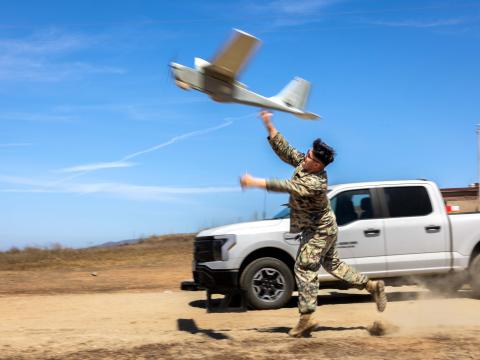Robot Navigation System Readies for Prime Time
A package of sensors, software and navigation equipment will soon permit U.S. Army ground robots, trucks and armored vehicles to move around a battlefield with minimal human supervision. The Autonomous Navigation System (ANS) allows robots to perceive and follow paths and other vehicles. The system recently completed its critical design review and is now moving on to the prototype fabrication stage.
The system is also an important part of the Army’s modernization efforts because it will be the primary sensor and navigation system for the Army’s XM1219 Armed Robotic Vehicle-Assault-Light (ARV-A-L) and the robotic Multifunction Utility/Logistics and Equipment (MULE) vehicle, says ANS project lead Larry Hennebeck.
Vehicle sensors are located in perception modules, each one a cluster of three daylight, infrared and low-light cameras. Platforms such as the ARV and MULE will be equipped with four perception modules, one on each side of the vehicle. The front and rear modules are augmented with light detection and ranging systems to map the terrain directly ahead of and behind the vehicle. The ANS also features a millimeter wave radar on the front of the robot to track moving vehicles and objects approaching.
Additional features include Global Positioning Systems and inertial navigation capabilities. Hennebeck notes that the ANS computer, which he describes as a supercomputer class system, manages the robot’s path planning, video processing, object processing, sensor processing, and speed and curvature controls.
For planned missions, the software interprets commands from an external operator. Using geospatial data, the ANS computes the best path through waypoints provided by the operator. Using its sensors, an ANS-equipped vehicle will avoid obstacles while navigating to the waypoints. The system continuously revises routes to find the easiest path to an objective and provides position data and motion commands to the vehicle in the autonomous mode.
Incoming sensor data is processed by the onboard computers and software to detect, avoid and track obstacles, people and other vehicles. The system also provides soldiers with a situational awareness virtual presence for vehicle survivability and a precision weapons aiming and pointing systems for the ARV’s weapons.
Vehicles can be teleoperated through the ANS and commanded to follow other vehicles or a dismounted soldier. The system also can be integrated into other platforms such as Stryker infantry vehicles and trucks, says Lt. Col. Jay Ferreira, USA, product manager for unmanned ground vehicles, Program Executive Office Integration. He adds that as part of the process of designing and developing the system and proving the algorithms, program members tested ANS-equipped Strykers and trucks in robotic convoy exercises.
Col. Ferreira notes that developing the ANS is a holistic process with program building and testing done in increments. The program also tests each component and how well the software controls the surrogate vehicles. He contends that the increments are necessary because of the software’s complexity.
When the ANS is incorporated into a manned vehicle such as a Stryker, the cameras and sensors add to the crew’s situational awareness by providing a wide-angle view through onboard monitors. The vehicle’s driver can navigate by looking at the screen rather than the vehicle’s periscopes.
The ANS has accomplished many of its program goals over the last several years, says Hennebeck. Among the design review milestones, he notes that the program has completed 93 percent of its 811 requirements. This includes manufacturing components for additional test models, defining use cases and conducting testing such as blast and shock trials. The program has conducted more than 2,000 system field tests. The critical design review was completed March 31, 2010, and will be fully closed on August 27.
The program’s next step will be integrating the ANS onto the ARV, says Dan Folk, deputy product manager for unmanned ground vehicle development (formerly Future Combat Systems). The ARV’s critical design review is scheduled for October 2010. For the next six months, he shares that the ANS and ARV teams will work together to ensure that their requirements are synchronized. After the ARV design review in October, that program will begin building prototype platforms on which the ANS system will be integrated and tested in early 2012.



Comments